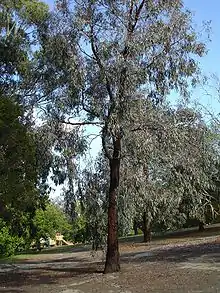Eucalyptus sideroxylon
Eucalyptus sideroxylon, commonly known as mugga ironbark,[3] or red ironbark[4] is a small to medium-sized tree that is endemic to eastern Australia. It has dark, deeply furrowed ironbark, lance-shaped adult leaves, flower buds in groups of seven, white, red, pink or creamy yellow flowers and cup-shaped to shortened spherical fruit.
| Mugga ironbark, red ironbark | |
|---|---|
 | |
| Scientific classification | |
| Kingdom: | Plantae |
| Clade: | Tracheophytes |
| Clade: | Angiosperms |
| Clade: | Eudicots |
| Clade: | Rosids |
| Order: | Myrtales |
| Family: | Myrtaceae |
| Genus: | Eucalyptus |
| Species: | E. sideroxylon |
| Binomial name | |
| Eucalyptus sideroxylon | |
 | |
| E. sideroxylon, field distribution | |


Description
Eucalyptus sideroxylon is a tree that typically grows to a height of 25–35 m (82–115 ft) and forms a lignotuber. The bark is dark grey to black, deeply furrowed ironbark on the trunk and larger branches, smooth white to grey on the thinnest branches. Young plants and coppice regrowth have lance-shaped to oblong or linear leaves that are 30–110 mm (1.2–4.3 in) long and 5–35 mm (0.20–1.38 in) wide. Adult leaves are lance-shaped, the same shade of green on both sides, 50–140 mm (2.0–5.5 in) long and 10–40 mm (0.39–1.57 in) wide tapering to a petiole 5–25 mm (0.20–0.98 in) long. The flower buds are arranged in leaf axils on an unbranched peduncle 7–29 mm (0.28–1.14 in) long, the individual buds on pedicels 3–15 mm (0.12–0.59 in) long. Mature buds are oval or diamond-shaped, 6–15 mm (0.24–0.59 in) long and 4–6 mm (0.16–0.24 in) wide with a conical to beaked operculum. Flowering occurs from April to December and the flowers are white, red, pink or creamy yellow. The fruit is a woody cup-shaped to shortened spherical capsule 5–11 mm (0.20–0.43 in) long and 5–10 mm (0.20–0.39 in) wide with the valves below the level of the rim.[3][5][6][7][8]
Taxonomy and naming
Allan Cunningham recorded the name Eucalyptus sideroxylon in Thomas Mitchell's 1848 Journal of an Expedition into the Interior of Tropical Australia but did not provide a description of the plant. The first formal description of the species was published in 1887 by William Woolls in Proceedings of the Linnean Society of New South Wales.[9][10] The specific epithet (sideroxylon) is derived from the ancient Greek words sidēros (σίδηρος), meaning "iron" and xylon (ξύλον), meaning "wood".[11]
Two subspecies of E. sideroxylon are accepted by the Australian Plant Census as at December 2019:
Distribution and habitat
Mugga ironbark is widespread and often abundant in woodland from south-eastern Queensland through New South Wales to Victoria. Subspecies improcera is only known from the Barakula State Forest north-northwest of Chinchilla.[3][5][13]
Uses
The leaves are used in the production of cineole based eucalyptus oil.[15]
Apiarists in New South Wales place hives in red-ironbark woodlands to collect the honey.[8]
Chemistry
Molecules produced by plants in case of pathogens attacks are called phytoalexins. Such compounds can be implied in the hypersensitive response of plants. High levels of polyphenols (stilbenoids and ellagitannins) in E. sideroxylon wood can explain its natural preservation against rot.[16]
References
- Fensham, R.; Laffineur, B.; Collingwood, T. "Red Ironbark Eucalyptus sideroxylon". IUCN Red List of Threatened Species: e.T133377043A133377045. doi:10.2305/IUCN.UK.2019-3.RLTS.T133377043A133377045.en. Retrieved 26 June 2023.
- "Eucalyptus sideroxylon". Australian Plant Census. Archived from the original on 23 December 2019. Retrieved 23 December 2019.
- Hill, Ken. "Eucalyptus sideroxylon". Royal Botanic Garden Sydney. Archived from the original on 19 August 2023. Retrieved 22 December 2019.
- Brooker, M. Ian H.; Slee, Andrew V. "Eucalyptus sideroxylon". Royal Botanic Gardens, Victoria. Archived from the original on 23 December 2019. Retrieved 23 December 2019.
- "Eucalyptus sideroxylon". Euclid: Centre for Australian National Biodiversity Research. Archived from the original on 22 June 2021. Retrieved 29 May 2020.
- Chippendale, George M. "Eucalyptus sideroxylon". Australian Biological Resources Study, Department of the Environment and Energy, Canberra. Archived from the original on 19 August 2023. Retrieved 23 December 2019.
- Messina, Andre; Stajsic, Val. "Eucalyptus sideroxylon subsp. sideroxylon". Royal Botanic Gardens, Victoria. Archived from the original on 23 December 2019. Retrieved 23 December 2019.
- Dean Nicolle (30 April 2010). "An illustrated guide to Australia's gum blossoms". Australian Geographic. Archived from the original on 17 November 2017. Retrieved 19 November 2017.
- "Eucalyptus sideroxylon". APNI. Archived from the original on 19 August 2023. Retrieved 23 December 2019.
- Woolls, William (1887). "Notes on Eucalyptus leucoxylon (Series 2)". Proceedings of the Linnean Society of New South Wales. 1: 859–860. Archived from the original on 20 July 2019. Retrieved 23 December 2019.
- Backer, C.A. (1936). Verklarend woordenboek der wetenschappelijke namen van de in Nederland en Nederlandsch-Indië in het wild groeiende en in tuinen en parken gekweekte varens en hoogere planten (Edition Nicoline van der Sijs).
- "Eucalyptus sideroxylon subsp. improcera". Australian Plant Census. Archived from the original on 23 December 2019. Retrieved 23 December 2019.
- Bean, Anthony R. (2010). "A new subspecies of Eucalyptus sideroxylon A.Cunn. ex Woolls (Myrtaceae) from Queensland". Austrobaileya. 8 (2): 139–141. JSTOR 41739124.
- "Eucalyptus sideroxylon subsp. sideroxylon". Australian Plant Census. Archived from the original on 23 December 2019. Retrieved 23 December 2019.
- Boland, D.J., Brophy, J.J., and A.P.N. House, Eucalyptus Leaf Oils, 1991, ISBN 0-909605-69-6
- Hart, John H.; Hillis, W. E. (1974). "Inhibition of wood-rotting fungi by stilbenes and other polyphenols in Eucalyptus sideroxylon". Phytopathology. 64 (7): 939–48. doi:10.1094/Phyto-64-939.
